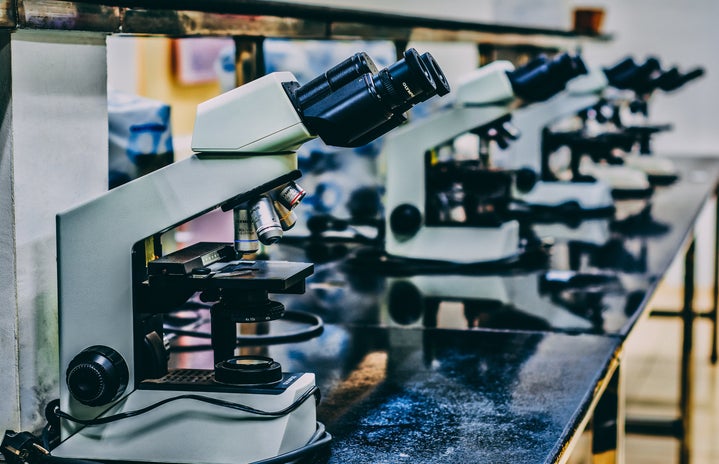Women make up only 28% of the workforce in STEM (Science, Technology, Engineering, and Math) and men hugely outnumber women majoring in most STEM fields. As a STEM student myself I know how it feels to be in a male-dominated room, however, my experiences as a 21st-century female scientist are meagre compared to the women who paved the way and fought for their right to pursue careers in STEM. This series called ‘Women Who Got Us Where We Are’ will provide weekly profiles on inspirational women in STEM.
My degree is in Natural Sciences, and within that, I focus on biosciences and climate science. These are the subjects which have the highest proportion of females, even so, women make up 46% of biological scientists, but a harsher figure is women only make up 16.5% of engineers.
rosalind Franklin
My first inspiration, Rosalind holds a very special place for me which is why I have decided to start this series with her. Back in GCSEs I remember being taught about the structure of DNA and being told that Watson and Crick discovered the structure. However, my teacher at the time showed us a documentary in which Rosalind was mentioned. I went home that day and did my research on her; I ordered a biography ‘Rosalind Franklin: The Dark Lady of DNA’. I engulfed the book, my emotions ranging from anger to awe, of this incredible woman.
Rosalind comes from a large Jewish family who lived in London, and from an early age, she had an interest in science and the world. She read through the whole Bible to find a reason for believing in God and concluded “how do you know He isn’t a She?”. At 15 she decided she wanted to become a scientist. She applied to Cambridge University to study physical chemistry, passed the entrance exams and got in. Her father strongly disapproved of university education for women and particularly disapproved of his daughter perusing a career in science. He believed that women should do good work as volunteers and they should not be professionals. Luckily, Rosalind had strong women in her family, her Aunt Alice Franklin was prepared to send Rosalind to Cambridge herself, but in the end, her mother paid for Rosalind’s education with her own family money.
In 1938 Rosalind attended Newnham College at Cambridge, which was (and still is) an all-girls college, to earn her ‘degree*’ in Physical Natural Sciences. At the time Newnham College had a policy that before a woman could invite a man into her room, she had to move her bed out into a public corridor. At this point, Cambridge still did not allow women to earn the same degrees as their male counterparts.
*Only 10 years later in 1948 did Cambridge actually begin to award degrees to women.
After graduating she worked with Ronald Norrish in London, which required her to cycle across London through air raids across the exposed Putney Common, a result of the outbreak of World War II. She never complained, but she was terrified and suffered nightmares from the cycle route for the rest of her life. During this period, she published five papers on coals and carbons which are still quoted greatly today and gave her a PhD from Cambridge University in 1945. This work went on and contributed to improvements in gas mask technology in WW2, which used charcoal to purify the air. At this time, she decided she did not want children because she loved them too much to hand them over to nannies, and her commitment to science prevented her from being a full-time mother – her duty and passion for her work is so striking.
In the early 1950’s Rosalind almost discovered (by herself) the structure of DNA, while working at King’s College London. DNA, the molecular basis for heredity, was unknown up until this point, and genetics was a scientific mystery. James Watson and Francis Crick beat her in this race, they used the data she had spent years collecting without her knowledge and without fully crediting her. They went on to win a Nobel Prize, and Rosalind is a forgotten piece of history, not even mentioned in textbooks used today, even though it is her Photograph 51 that is usually shown in textbooks.
Her colleagues and peers are said to have critiqued her lectures like a beauty contest, and Watson is quoted to have wondered “how she would look if she took off her glasses and did something novel with her hair”, although Rosalind never wore glasses… the quote still paints a picture of how men viewed women in the workplace (and still do), with physical appearance taken more seriously than the work they produce. Her co-worker in the lab, Maurice Wilkins, constantly bickered “Franklin barks often but doesn’t succeed in biting me” (a b*tch reference? I’ll let you form your own opinions). They had a very troubled relationship as he re-interpreted all of her data, leaving Franklin feeling betrayed from constantly being doubted, on top of this Maurice refused to refer to her as Dr Franklin, and instead called her Ms Franklin, once again undermining her position as a female scientist, and refusing to see her as a peer because of her gender. Had Maurice been able to cooperate with sharing a lab with a woman then maybe the Nobel Prize for the discovery of DNA would have gone to them instead of Watson and Crick.
Outside her career in science, she loved to travel, going on 20 miles a day hikes over mountains, alone or with friends. She lived in France for a few years and loved to meet people from all around the world.
In 1956 Franklin was diagnosed with ovarian cancer, and for the following 18 months, she went through numerous surgeries and other treatments, including experimental chemotherapy. During which she continued working in her lab and on her projects. She is said to have crawled up the stairs from her basement laboratory to her office on the second floor, due to pain and weakness from the treatments. This intense pain didn’t stop her from working until she was physically bed-bound by her illness, she died aged 37. Although she never won a Nobel prize, she is referenced in the book ‘Nobel Prize Women in Science’ (a very great read if you need a recommendation).
Rosalind inspires and fascinates me; she was so strong and sure of what she wanted from life despite her father and all the other boundaries in her way. She pursued her desire to become a researcher at a time when it was still extremely hard for women to have a career in science. She overcame all these challenges and made some of the most important discoveries in scientific history.
I guess in some ways I relate to Rosalind, I have never questioned myself and have always known that science was the route I would take in life. I love travelling and immersing myself in new environments, although I haven’t quite managed to hike 20 miles in one day or contributed to major scientific work (yet … ). What I have learnt from Rosalind is to pursue your passions, and don’t ever doubt yourself.
Despite never knowing her, I am sure that she would despise the way in which she is remembered, which is more so for the things that have happened to her, rather than her incredible contributions to three different fields of science.
It’s so easy to forget among the troubles of today, how far we have come and how grateful we all can be to the women who came before us. But also, to inspire how much further we can go.
“Science and everyday life cannot and should not be separated. Science, for me, gives a partial explanation of life. In so far as it goes, it is based on fact, experience, and experiment.” – Rosalind Franklin
“What’s the use of doing all this work if we don’t get some fun out of this?” – Rosalind Franklin.
“I would willingly go more primitive if it were necessary to preserve my freedom.“ – Rosalind Franklin.


